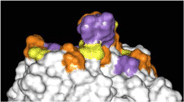An intimate historical and conceptual association exists between crystals and chirality. Yet the relationships between crystal symmetry and crystal morphology are not fully understood. In biological environments, molecular recognition between biological macromolecules and crystal surfaces can affect crystal morphological symmetry, or can be modulated by the symmetry expressed at the surfaces. The transfer of chiral information between biological macromolecules and ordered surfaces is considered here through several examples. Certain biogenic crystals of calcium oxalate exhibit a chiral morphology, although both molecular and crystal structures are non-chiral. This reduction in symmetry is believed to be induced by proteins during crystal nucleation. In contrast, crystals of calcium-{R,R}- and -{S,S}-tartrate tetrahydrate are inherently chiral, but their morphologies are symmetric. The chirality expressed by the crystal faces is however detected by cells, which selectively adhere to the {R,R} crystals. Structural insight into stereo- and enantio-selective recognition of chiral surfaces is provided by comparison between the degrees of recognition of four antibodies, raised and selected against crystal surfaces. A general framework is presented, where chirality can be understood at a length-scale larger than molecular, namely the length-scale of crystal surfaces, crystal morphology and the relations between them.

You have access to this article
 Please wait while we load your content...
Something went wrong. Try again?
Please wait while we load your content...
Something went wrong. Try again?


 Please wait while we load your content...
Please wait while we load your content...